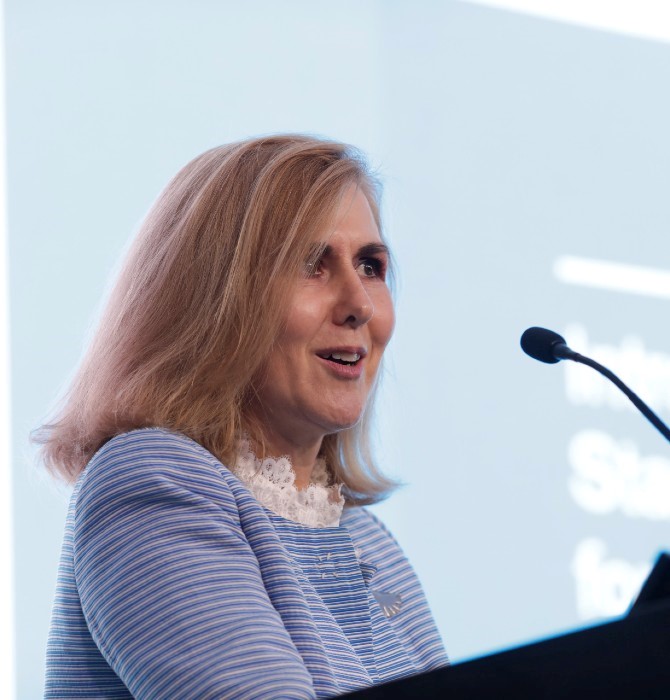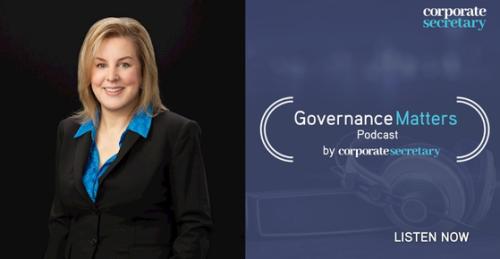The International Sustainability Standards Board (ISSB) published its first two global sustainability reporting standards in June this year. IFRS S1 General Requirements for Disclosure of Sustainability-related Financial Information and IFRS S2 Climate-related Disclosures aim to set a baseline level of disclosure to meet global market needs.
Unconventionally, the standards were launched in a series of events hosted by partners of the ISSB in locations around the world including Frankfurt, New York City, Singapore, Johannesburg, Lagos, Santiago and London. The ISSB chose the UK capital to officially launch the standards, with chair Emmanuel Faber giving a speech at the London Stock Exchange on June 26.
Sue Lloyd, vice chair of the ISSB, tells Corporate Secretary sister publication IR Magazine the decision to launch the standards in a series of events was taken by the organization to ‘mark how big an occasion this is, not just for the IFRS Foundation and the ISSB, but also for the global capital markets.’

ATTRACTING CAPITAL
Recalling the latter half of 2021, when the IFRS Foundation Trustees first announced the launch of the ISSB, Lloyd says the board has benefitted from continued desire on the part of international stakeholders for the markets to have a ‘robust, comparable and international language’ that’s used for sustainability reporting.
‘For me, with that context, it’s appropriate that we would make such an international splash because it’s such a big change that we’re so proud of and we want the market to notice,’ she says.
Lloyd adds that the standards are a targeted way to focus on the things investors need to understand: sustainability risks, but also sustainability opportunities. ‘It’s a targeted and focused way for a company to tell that story,’ she explains. ‘How am I managing sustainability risks? Why should you put your money with me?
‘It’s a way to emphasize where there are opportunities to attract capital, as well as investment opportunities. That’s the whole basis of our exercise. It’s efficient and effective reporting for companies to communicate with investors – I think that’s really what sets our standards apart.’
FOCUSED AND FINANCIALLY MATERIAL
Market reaction to the publication of the standards has been broadly positive, with many organizations, ESG experts and law firms welcoming the launch. Kathlyn Collins, vice president and head of responsible investment and stewardship at Matthews Asia, defines IFRS S1 and IFRS S2 as ‘the most streamlined standards that exist today’ because they focus on what matters financially.
She notes that other existing ESG frameworks widely adopted by global companies do prescribe certain elements to be reported, but they might not be material to a company’s business.
‘The newly released IFRS S1 and IFRS S2 are probably the most focused that exist,’ she says. ‘I’m not going to say they are the easiest [to apply] because they might be more technical and might require a little bit more co-ordination cross-departmentally within a company, but they’re probably the most material to the business itself. That’s why I think companies should focus on these.’
REALISTIC TIMELINES
It’s no secret that organizations, ESG, governance and IR teams worldwide have lamented the lack of a global ESG framework and harmonization of ESG rules across different jurisdictions.
The workload implications for reporting entities in terms of compliance, time, effort, systems and co-ordination required internally across businesses are significant. A poll conducted at the IR Magazine Think Tank – Europe, held a few days before the launch of the standards, found that nearly 70 percent of delegates did not feel ready for the introduction of IFRS S1 and IFRS S2.
But Lloyd says the ISSB has taken time and resources into account in the layout of its framework. ‘What’s important in our standards is that we know this is a really big change in reporting for many companies,’ she says. ‘[They] have been set up to be realistic about what we ask companies for in terms of timelines and the type of information needed.
‘Many companies are on the way to being ready – perhaps more prepared than they expected to be. If companies have used the TCFD recommendations or the SASB Standards, for example, our standards build on those. That means those companies have a good foundation for this type of reporting.’

PREPARATION PATHWAYS
Panos Seretis, global head of ESG research at Bank of America, agrees that corporates and investors have been preparing for some time on matters of environment-related disclosures on the back of other existing regulations.
‘This has been an area of focus for a lot of investors, but also for the European regulators,’ he notes. ‘[Consider] the Sustainable Finance Disclosure Regulation that already requires investors to disclose specific ESG KPIs. A lot of the corporates – in Europe, at least – have already been thinking about these KPIs and have started preparing. Of course, the ISSB has bigger scope to be global and standardize these KPIs, and [on that front ISSB] works with different organizations so they can come up with a consolidated solution.’
It’s true the TCFD recommendations have been adopted by thousands of listed companies around the world and therefore it’s good news that there is some commonality between TCFD and the ISSB standards – but it cannot be taken for granted that the process of implementing such standards will run smoothly. So what can companies do to prepare?
Lloyd highlights a few ways in which the standards introduce disclosure requirements in ‘a measured way’ that allows for a gradual approach. ‘In the first year, we don’t require reporting on risks beyond climate – that can start in the second year,’ she explains. ‘And when it gets to climate reporting, some of the disclosures – notably Scope 3 information – aren’t required in the first year and that’s to enable more time for companies to get ready. But even when you get to the details of the standards, we’ve tried to be proportionate as well.’
On the latter, Lloyd adds that the ISSB is aware that many companies will need to use estimation, but stresses it remains confident that ‘things will improve over time’.
Collins’ advice to companies considering the adoption of the standards is to start by identifying material sustainability factors. ‘If a company has been issuing ESG sustainability reports using GRI, TCFD or whatever their own national authority requires, that’s great,’ she says. ‘As a company you’ve probably already done a materiality mapping, so at this point you just need to conduct a gap analysis based on the current standards prescribed.’
As for companies that are still working on first implementations, Collins’ advice is to start with a materiality exercise. ‘That’s probably the hardest step because you want to gather the stakeholders that matter,’ she explains. ‘First, there is the need to understand what is material to the company, its employees, suppliers and customers, and then [work out] where all those issues fall within the materiality lenses.’
NOT A TICK-BOX EXERCISE
Sophie Platts, group head of sustainability at sports betting and gaming company Entain, believes there is a lot for companies to grapple with when it comes to regulations in the ESG space. ‘ESG and sustainability teams will need to balance reporting against increasing numbers of intricate standards while still delivering [their] sustainability strategy,’ she says.
Her advice when it comes to reporting against these requirements is to ‘not use this as a tick-box exercise, but as a lever for supporting internal engagement and drive the change that comes with these frameworks.’
These disclosure requirements are to be reported against every year, she adds. ‘The progress point is something that’s important – it’s not just about being compliant, it’s about what it means and how [it will] drive change across the business to make it more resilient,’ she notes.
The ISSB has reiterated multiple times that it will introduce programs to support the implementation of IFRS S1 and IFRS S2 in 2024. ‘We’re trying not to ask for the impossible and therefore it should be possible for all companies to get started and get moving on that journey with confidence that there are boundaries and support within the standards themselves, to get people going,’ says Lloyd.
THE SMALL-CAP CHALLENGE
The question about whether smaller companies should be held to the same standards as larger ones when it comes to ESG reporting remains wide open. Small-cap firms often do not have the internal resources to meet the level of ESG disclosure investors are looking for. But Lloyd says the standards are designed to be proportionate.
‘In many places where estimation is required, for example, we acknowledge that the information used by a company must be reasonable and supportable, but it’s using the information that’s available to a company without undue cost and effort,’ she explains.
‘Also, in a few places in the standards where we ask for quantitative information or approaches, we have provisions to say that if a company is not able to provide quantitative information, because it has more limited skills, resources and experience, [then] qualitative information is fine. The standards have been set up to accommodate different circumstances for companies.’
Collins says there needs to be a ‘capacity-building effort’ at the individual national level to help smaller businesses. ‘Whether that’s sessions held by regulatory bodies or by exchanges for IROs or C-suites to come and learn about the standards, I think that’ll be most helpful,’ she says. ‘And for some of the smaller companies that don’t have that, it could be overwhelming, because what we find at a lot of small and mid-cap companies is that they don’t even have a dedicated IR function yet.’
Regardless of internal resources, Seretis says the regulators expect the same from smaller companies. ‘There is a push from the regulator[s] for smaller companies to comply and disclose [ESG] information – that’s what we have seen in the market,’ he says.
Platts urges standard-setting bodies to take into account the pressure added to smaller companies every time a new piece of regulation comes out. ‘It is something I really sympathize with,’ she says. ‘It’s a lot of pressure and a lot of time taken up to collect the data, then trying to formulate it in a way that is needed to meet these requirements. I think that needs to be considered when organizations are setting out these frameworks because ultimately the main point is the delivery of change.’
VOLUNTARY VS MANDATORY
Should the ISSB standards be mandatory? ‘We would love our standards to be adopted by jurisdictions and regulators as a mandatory form of reporting,’ Lloyd says. ‘We would love that to happen because that’s a benefit to investors and companies as well and it’s similar to the journey we’ve seen with the IFRS accounting standards – which of course are part of the family – where jurisdictions have chosen to require the use of the standards.’
Collins agrees – but only when it comes to material disclosures. ‘I think they should be mandatory, but mandatory as material,’ she says. ‘If a company deems something to be not material to its business, it shouldn’t have to report it. Anything a company deems to be material should fall under mandatory reporting.’









